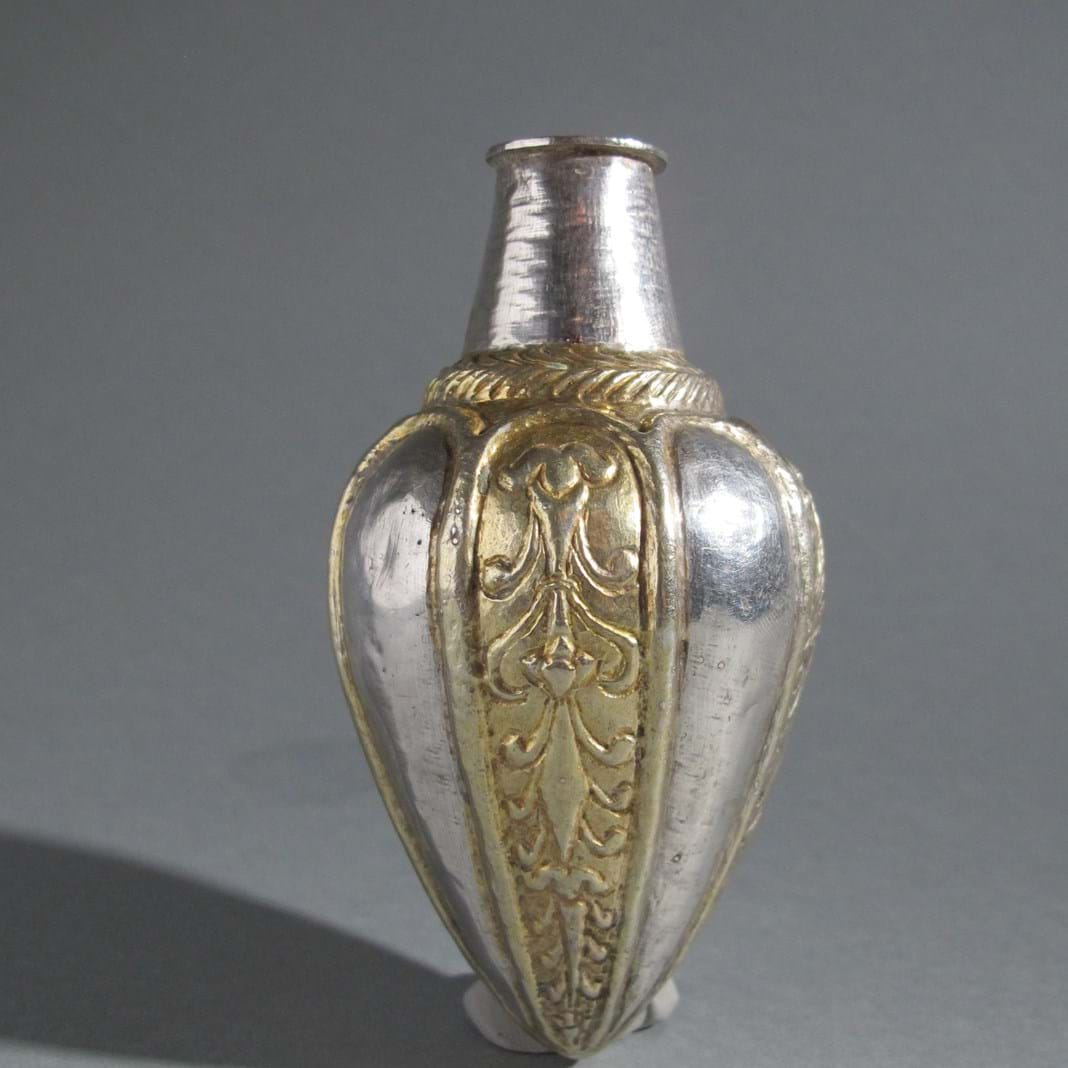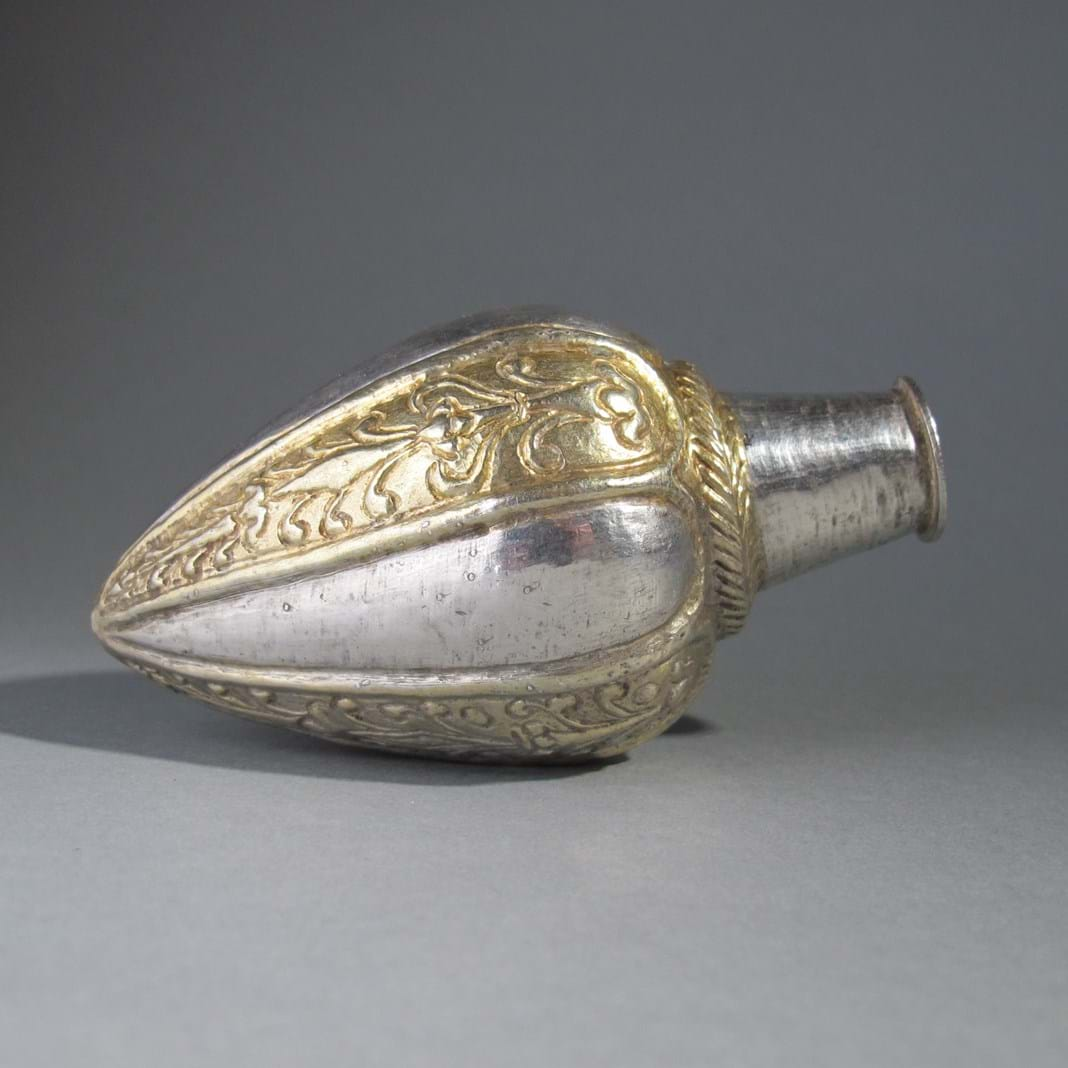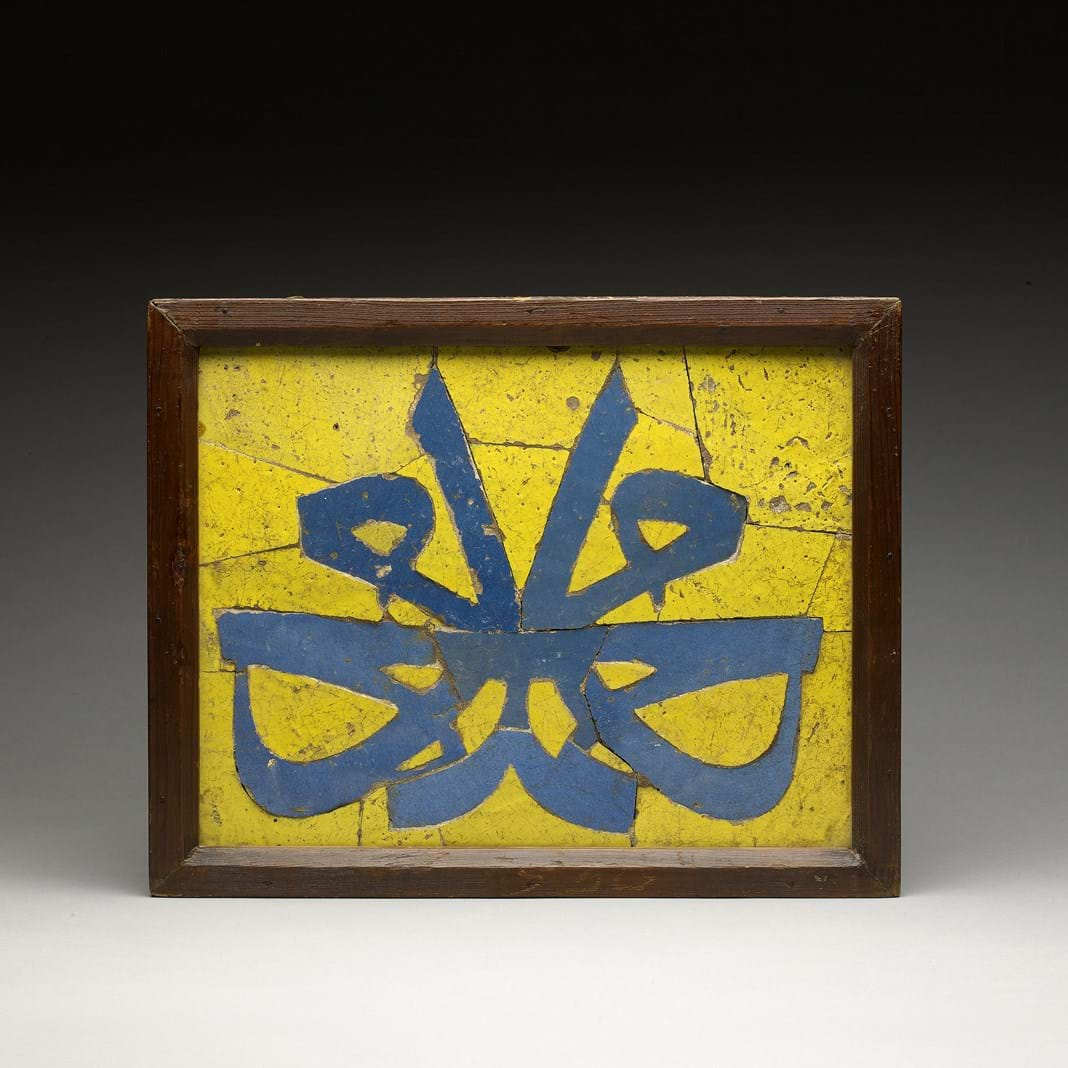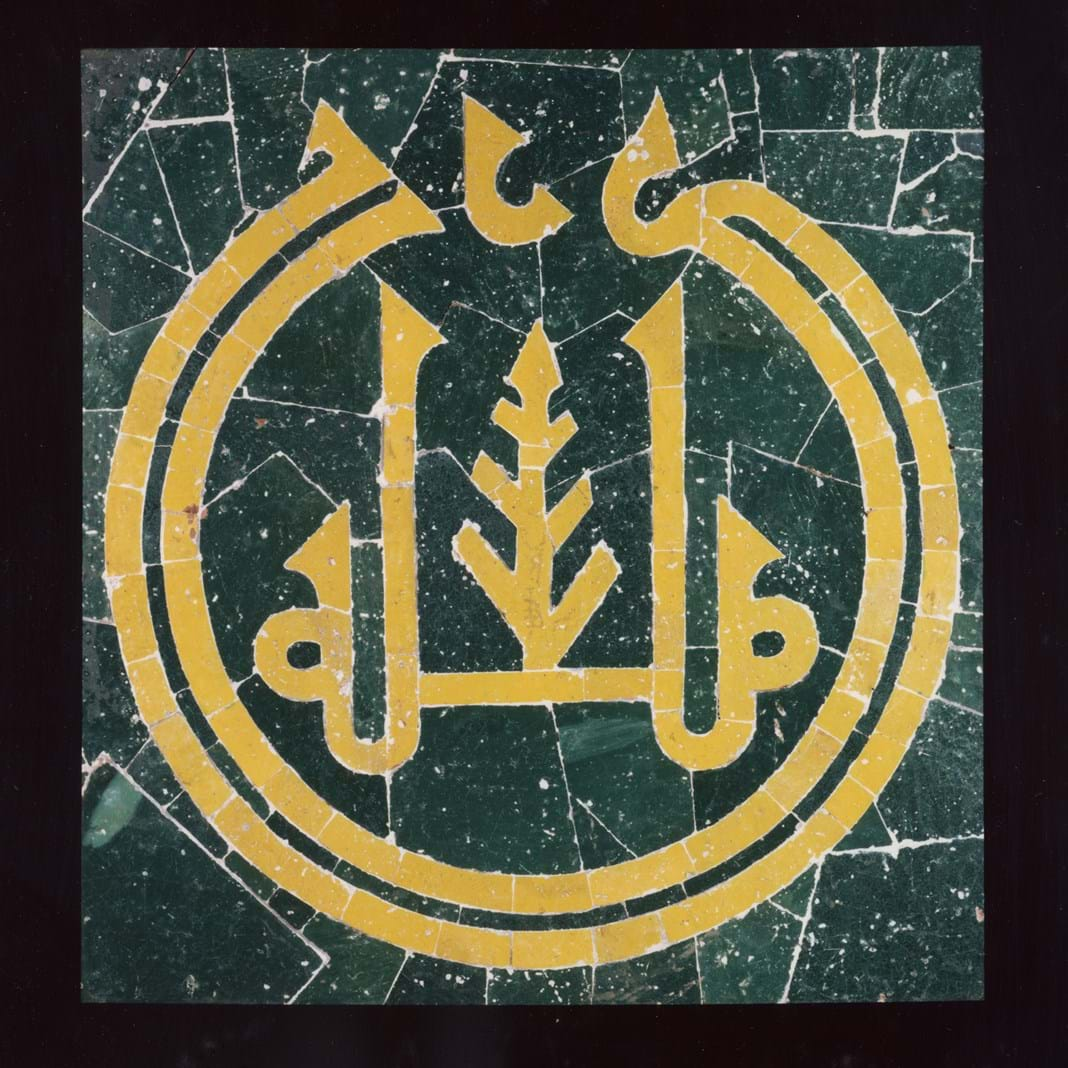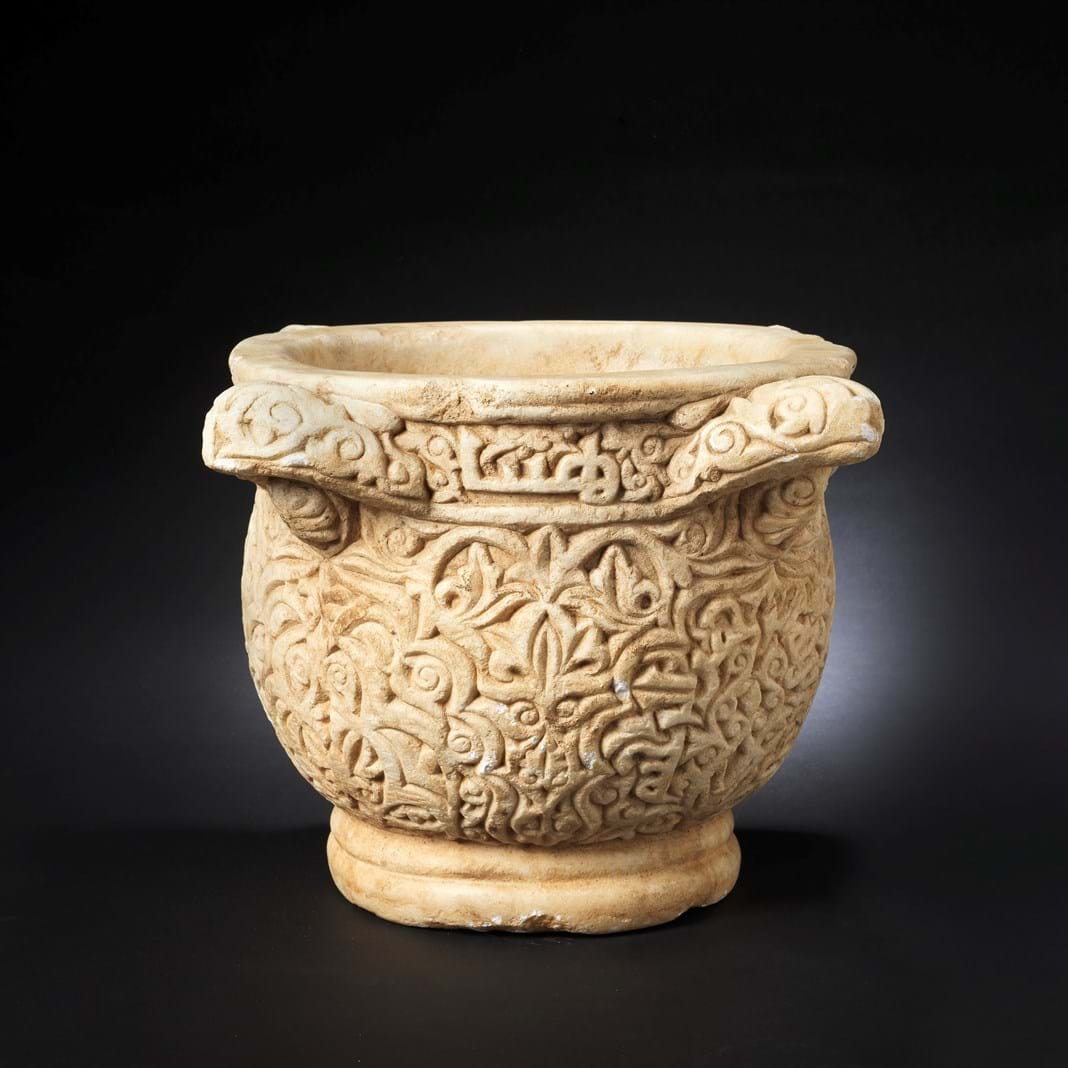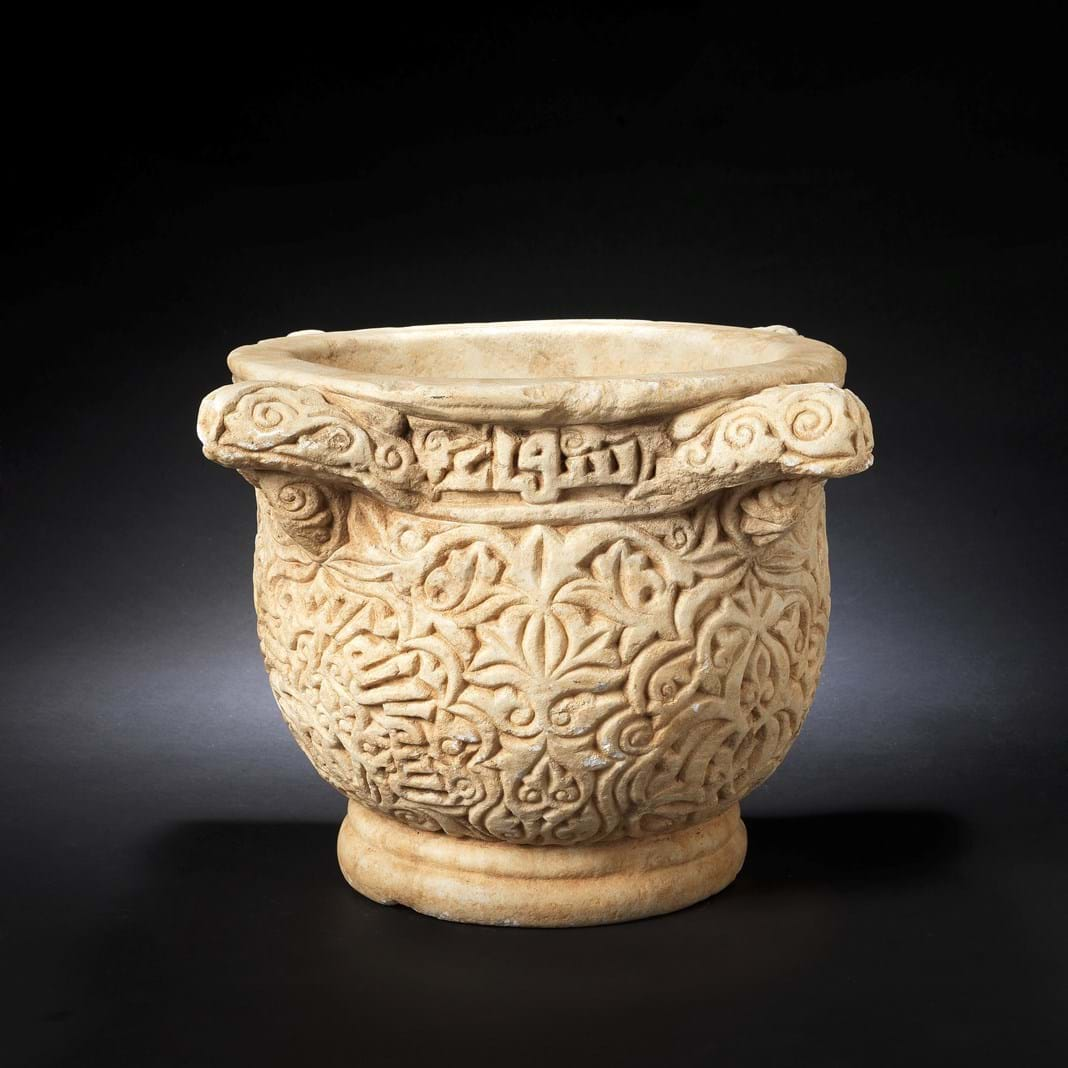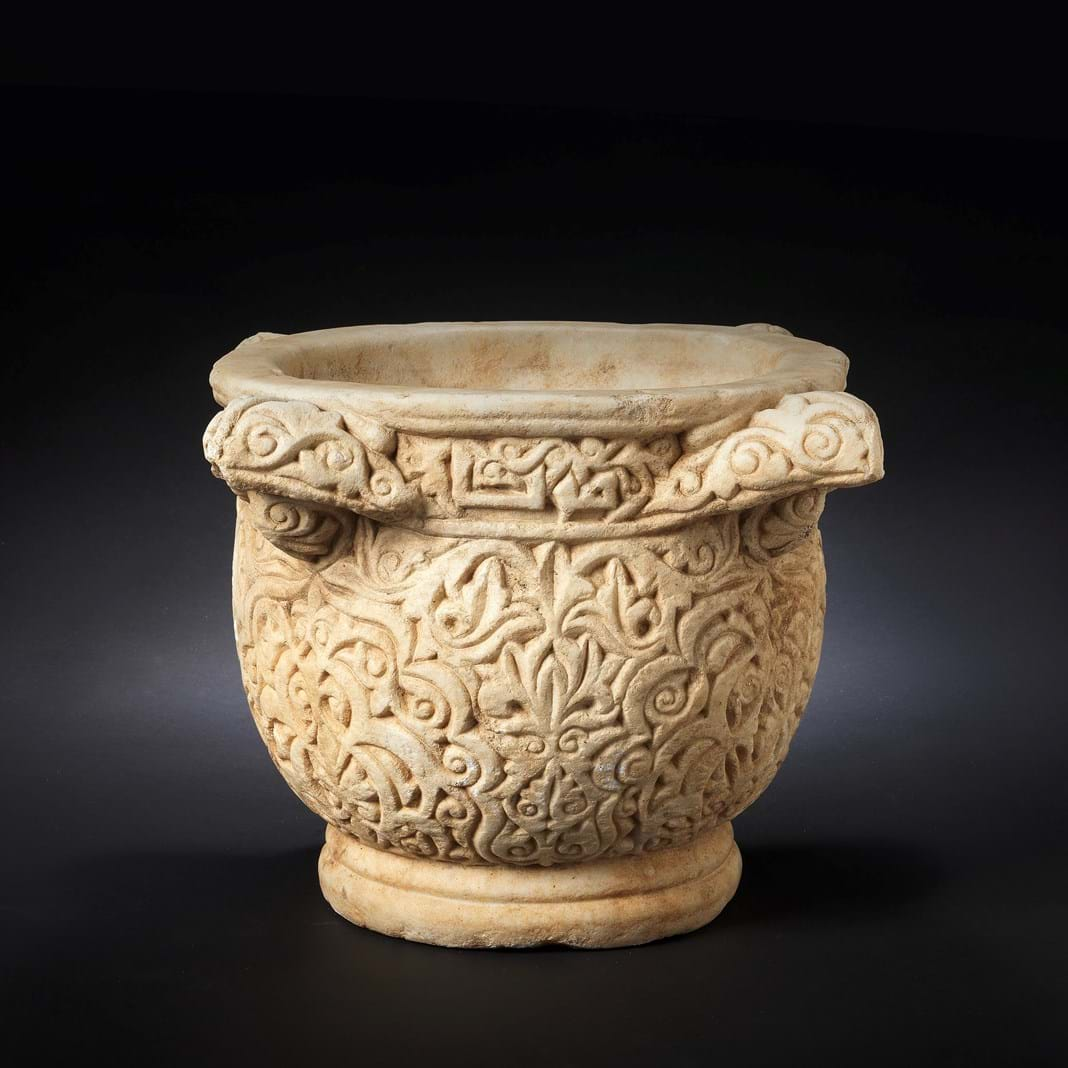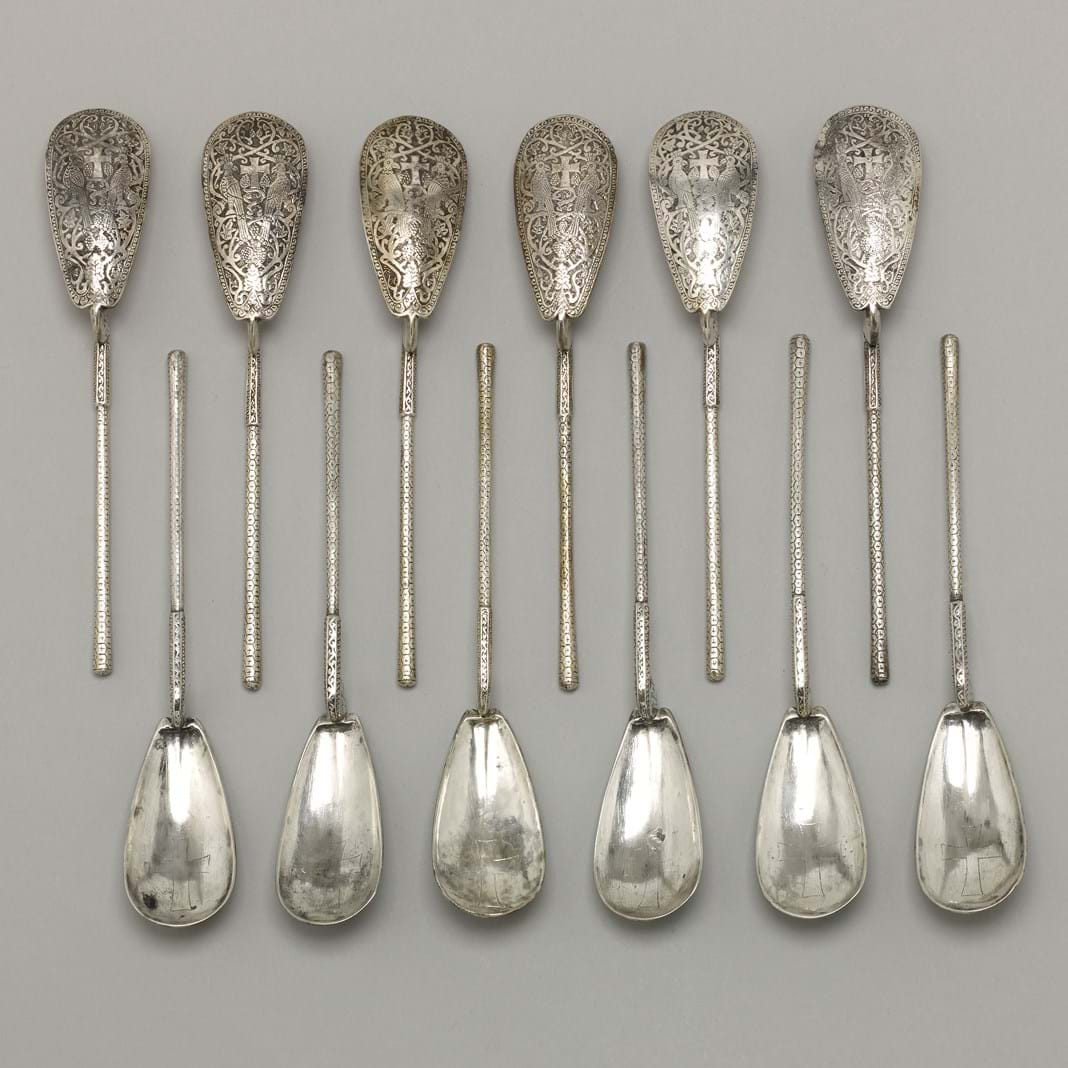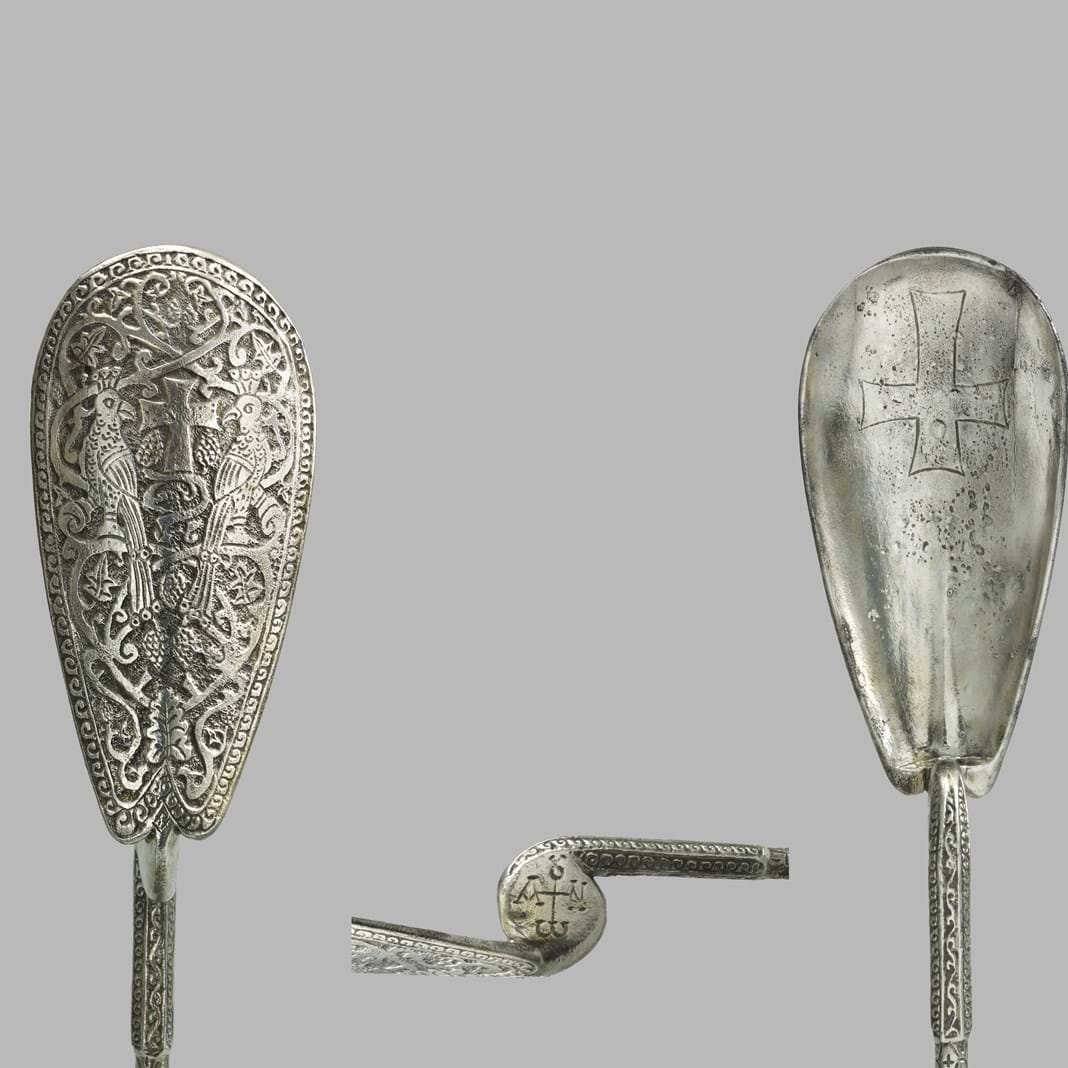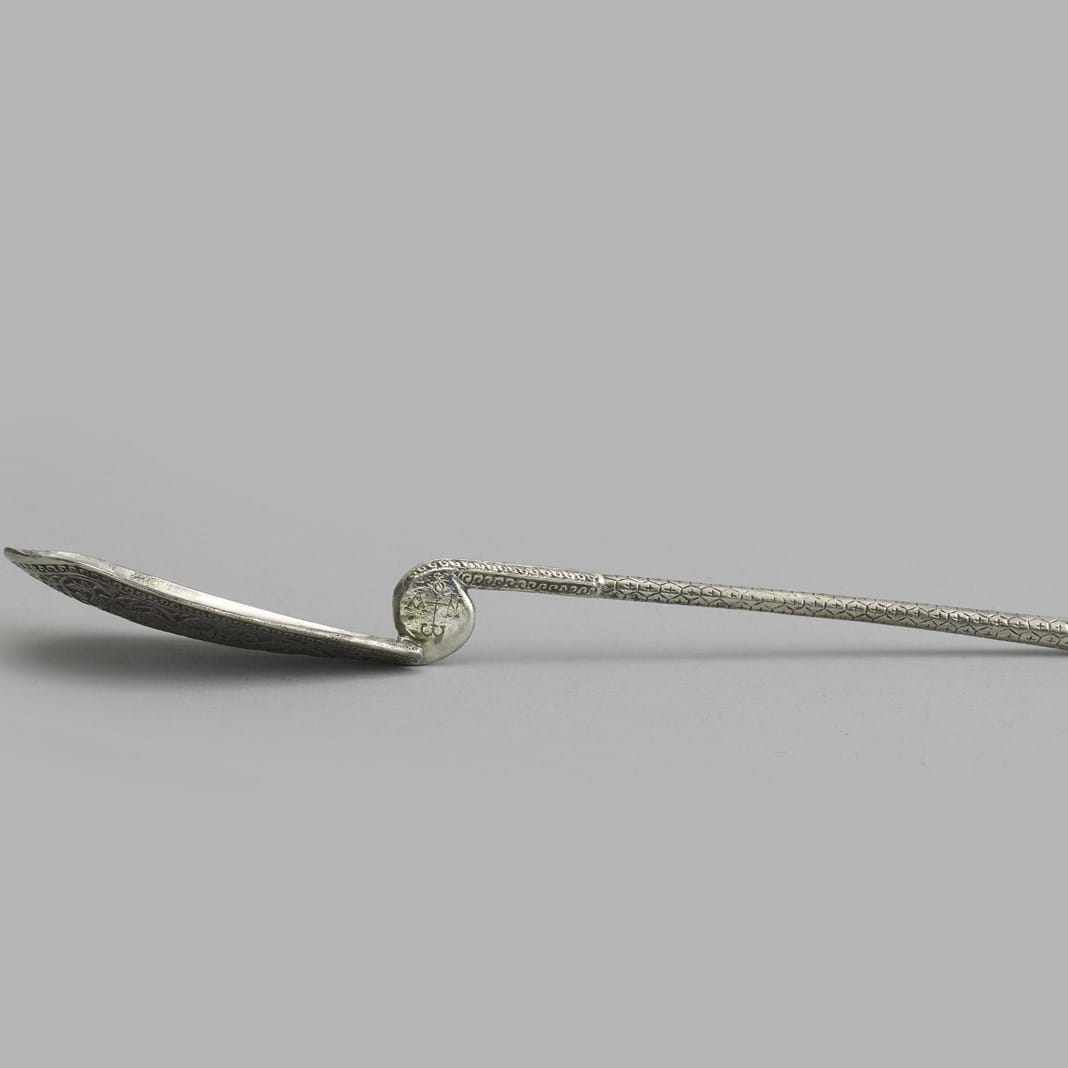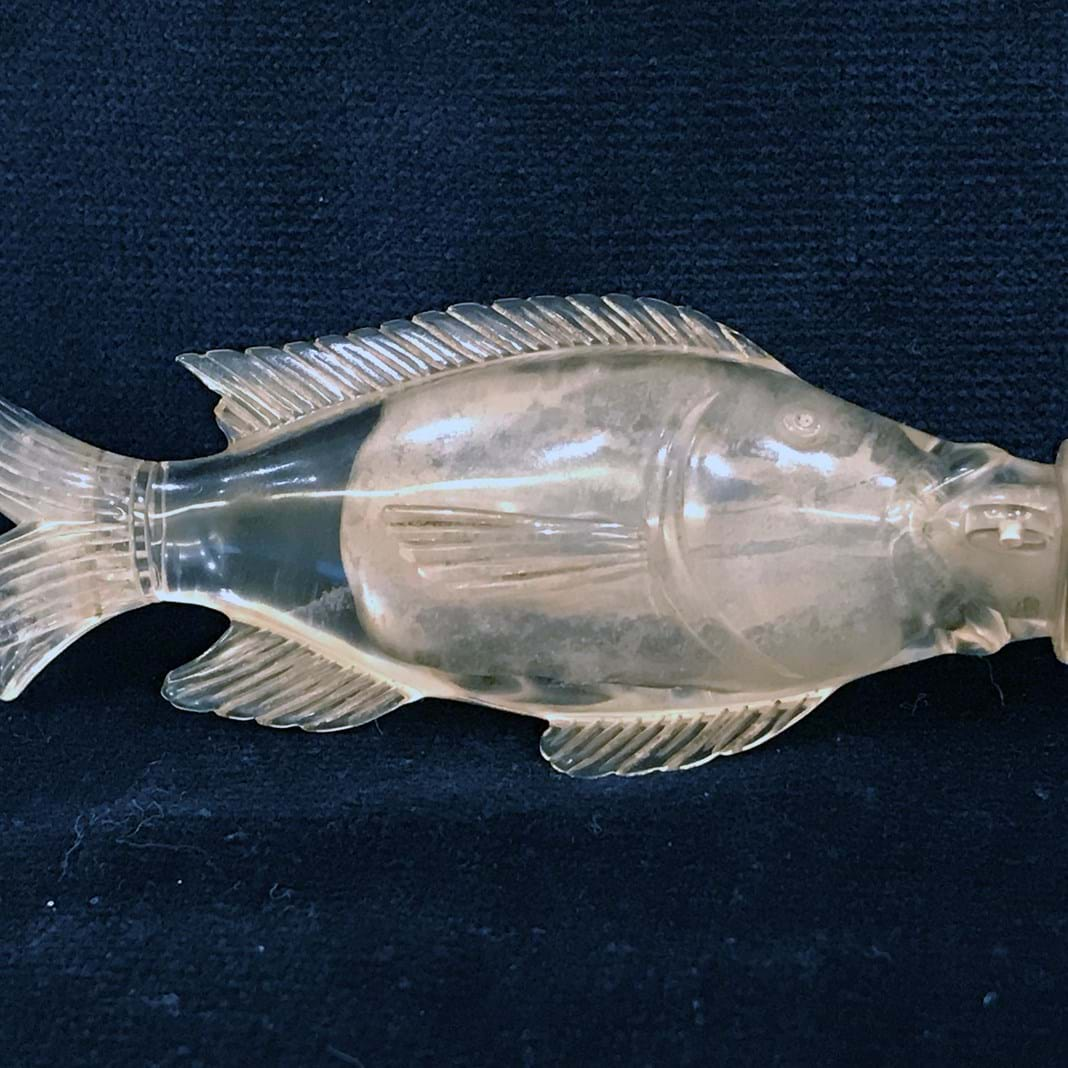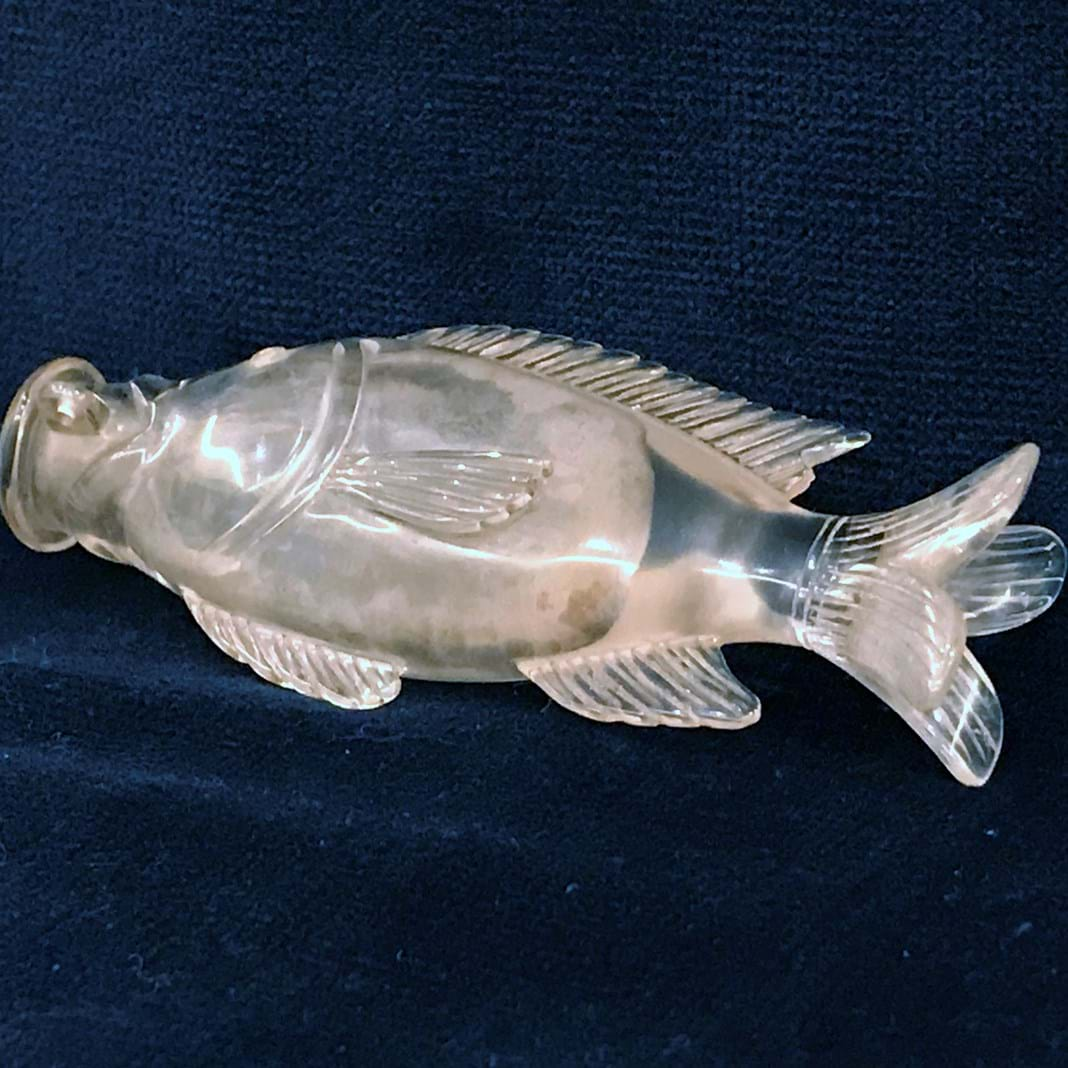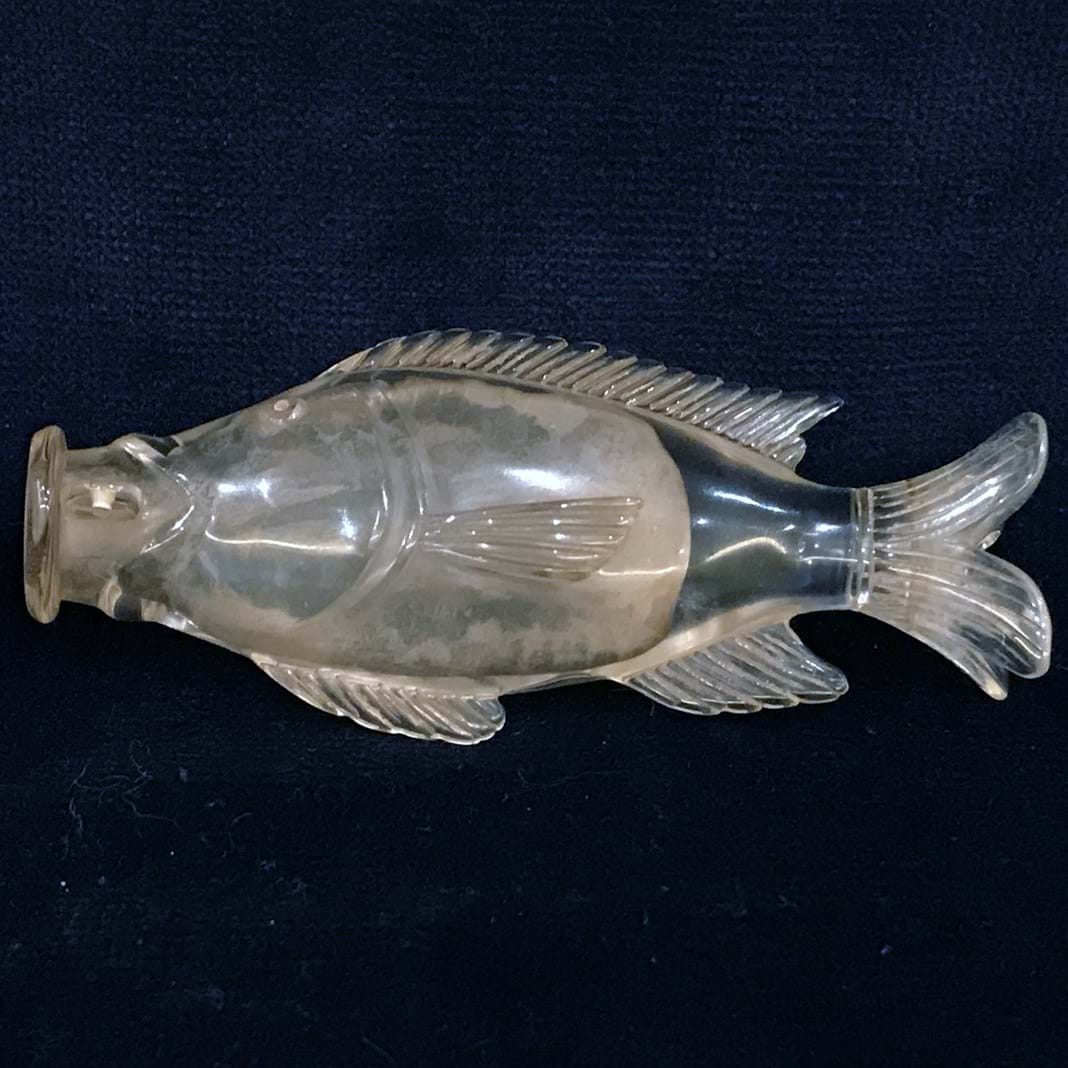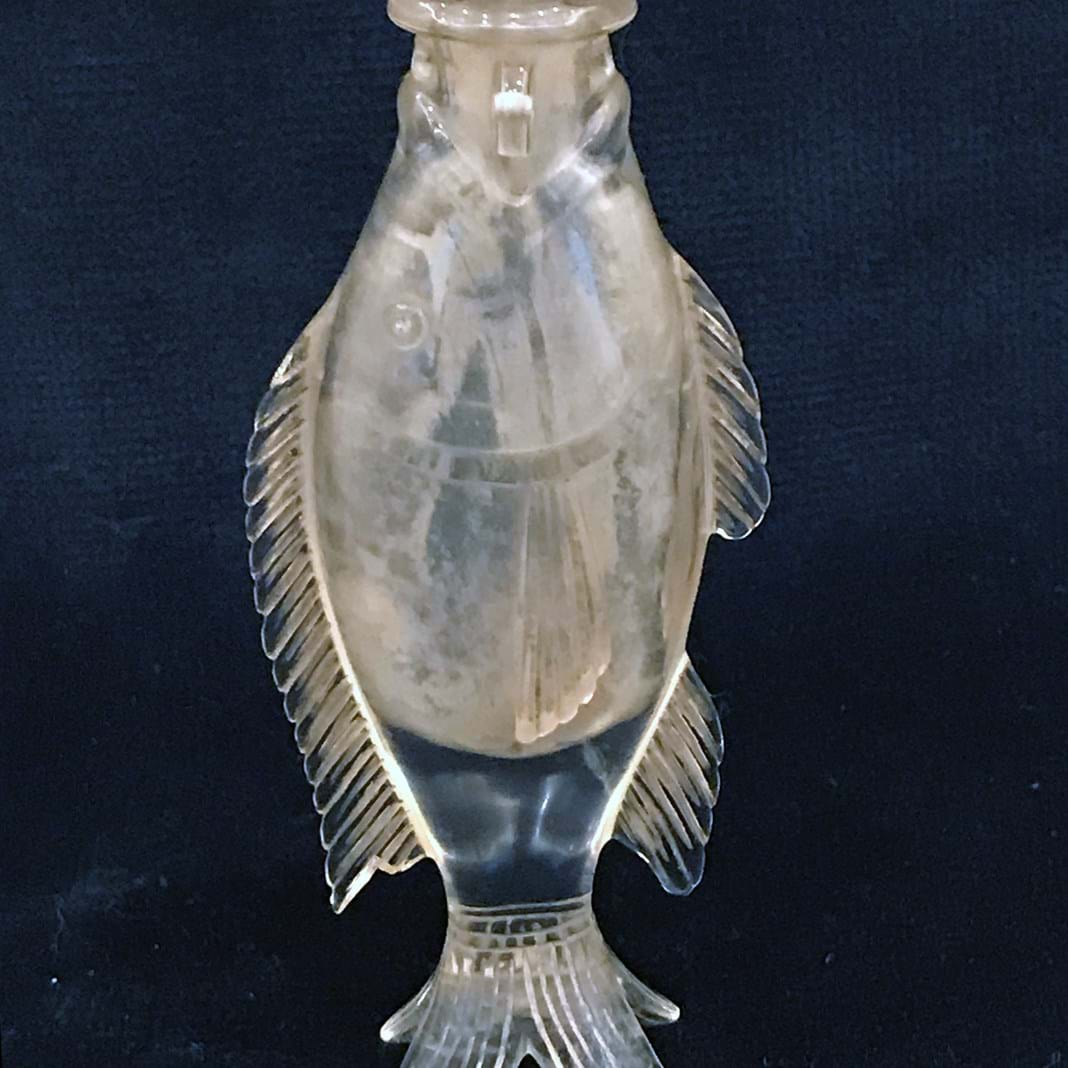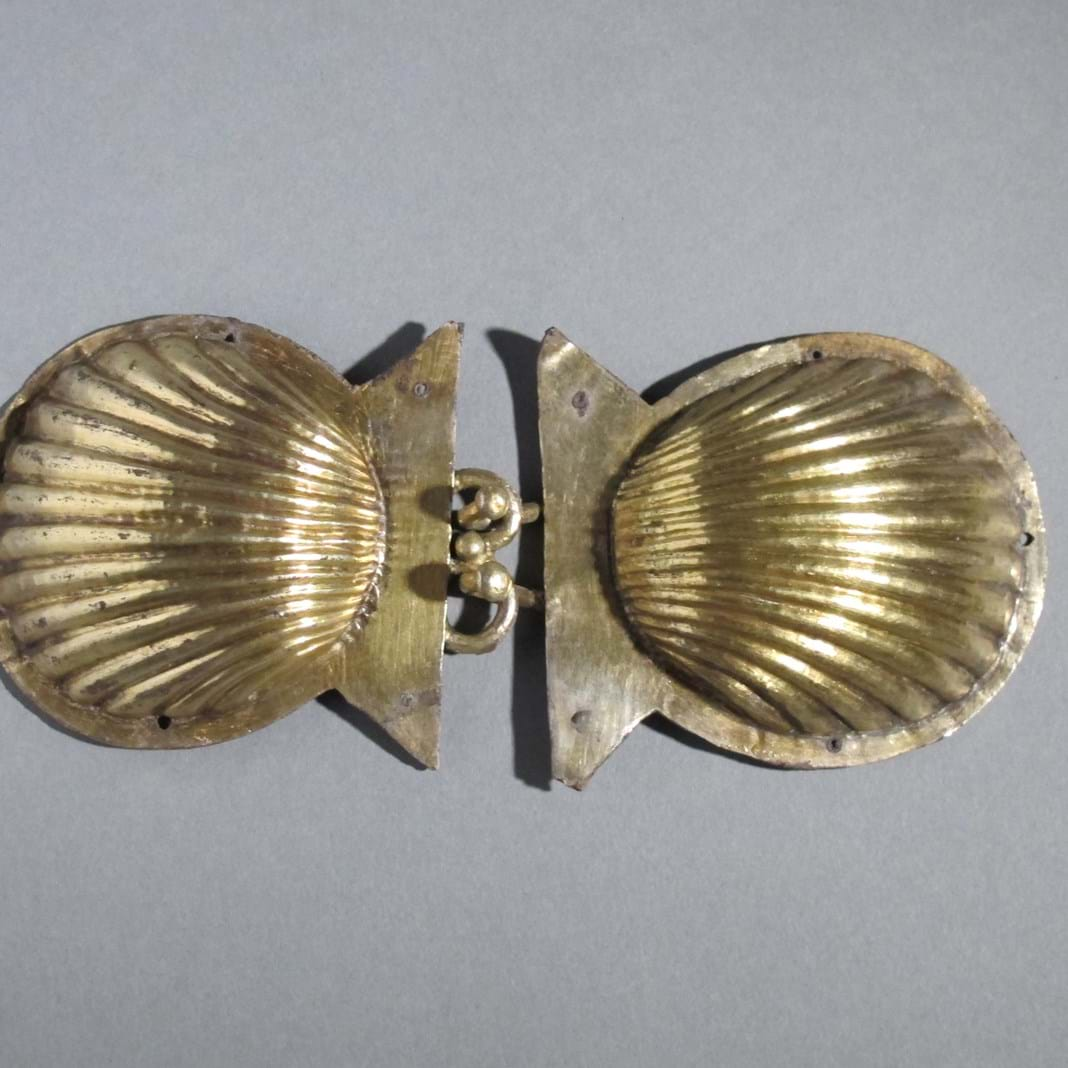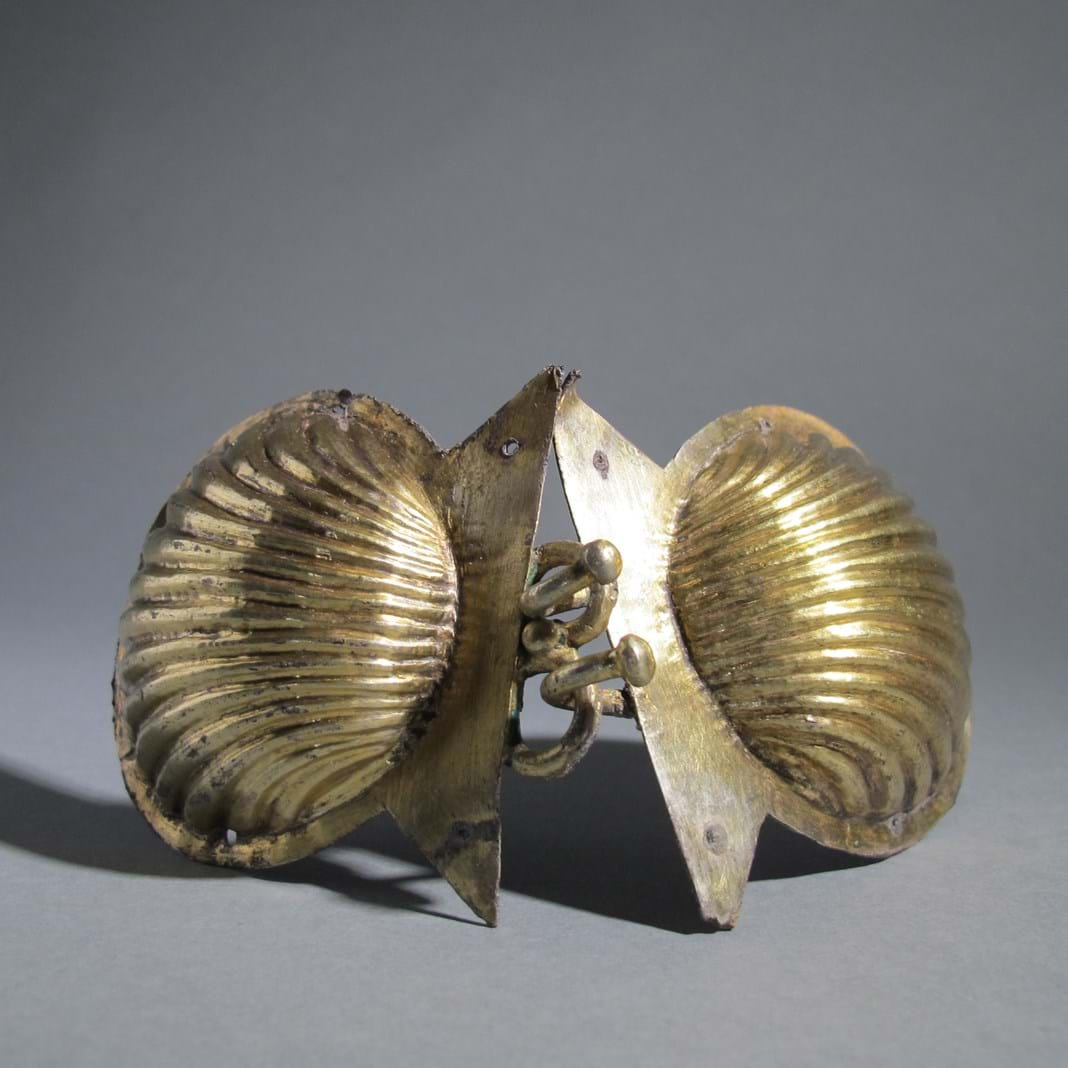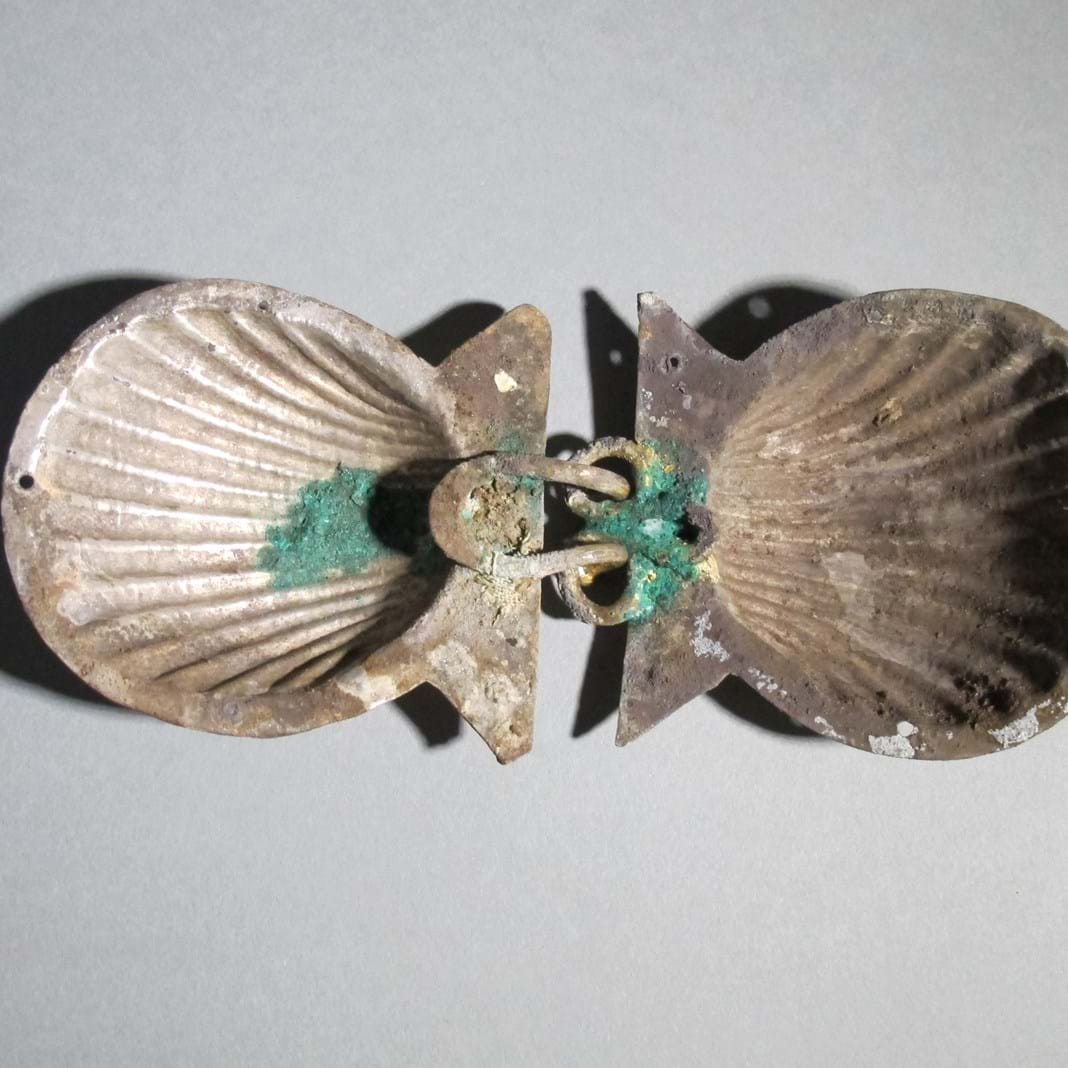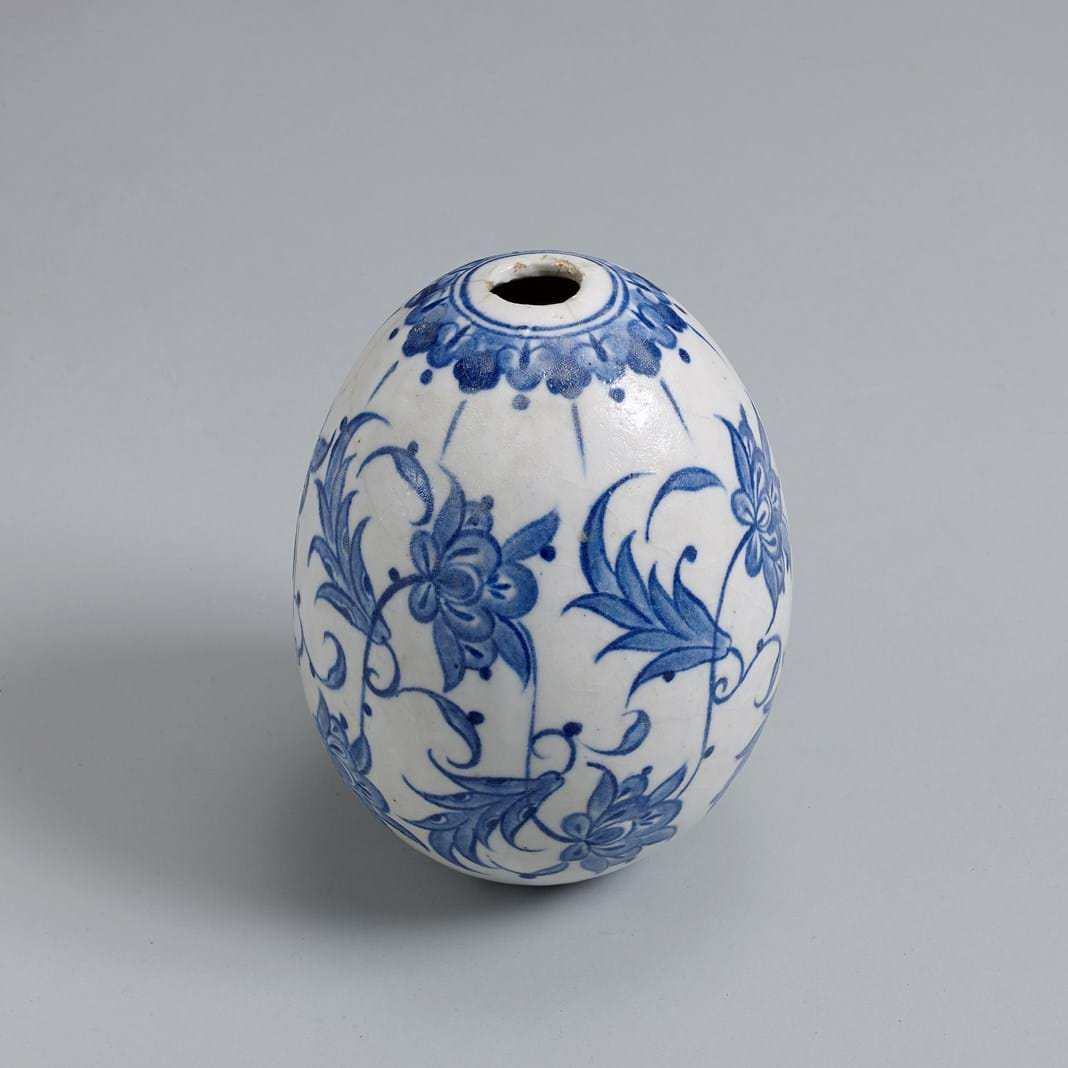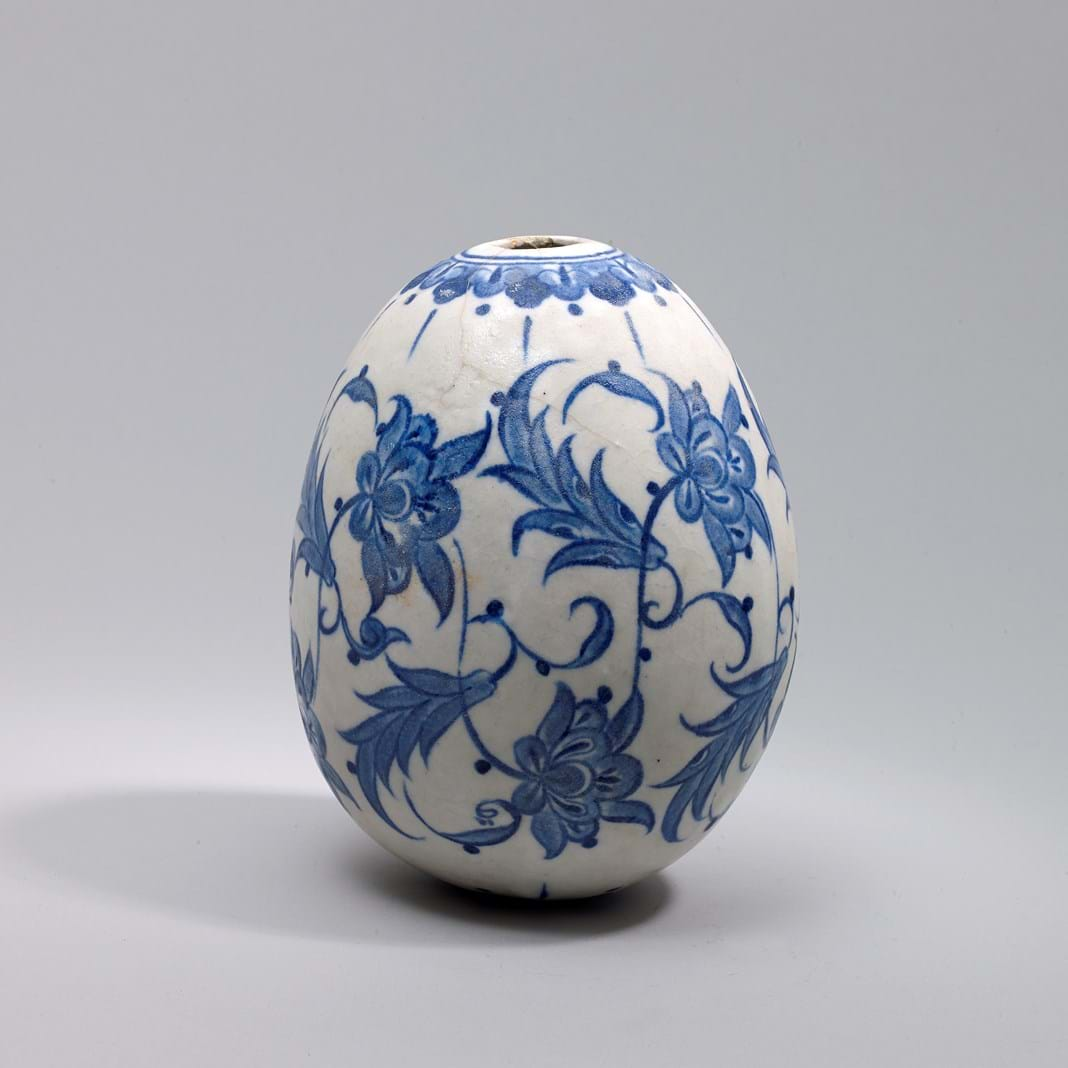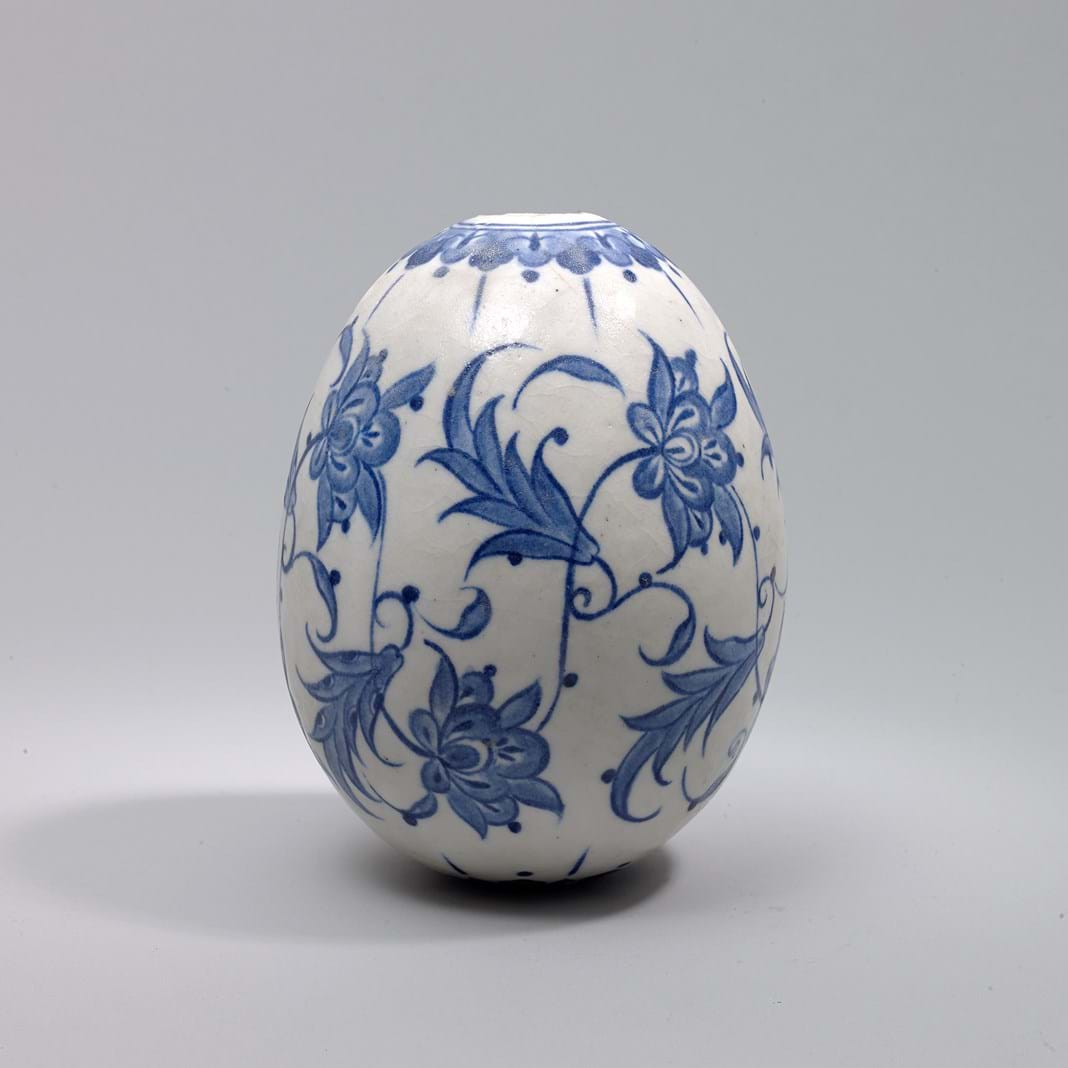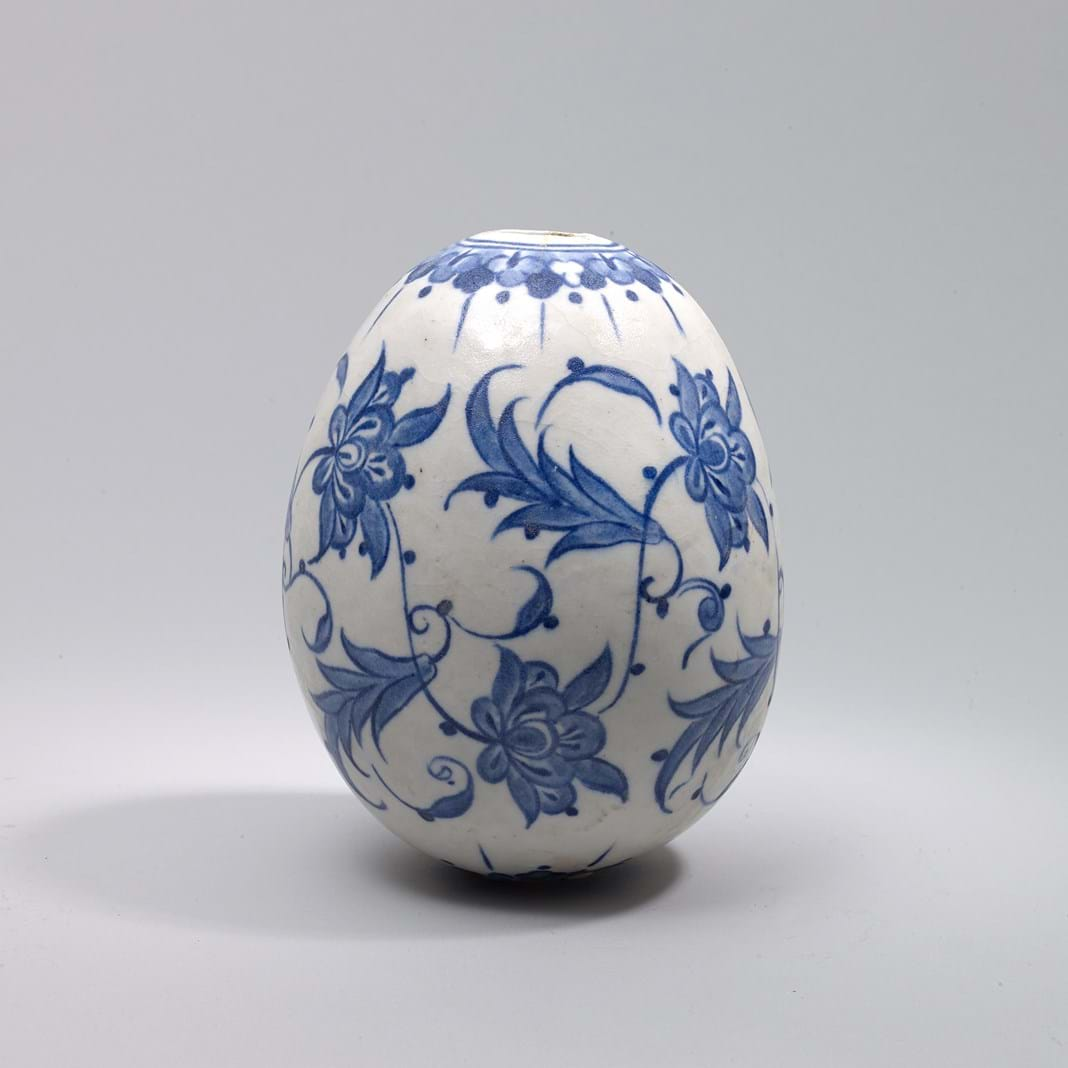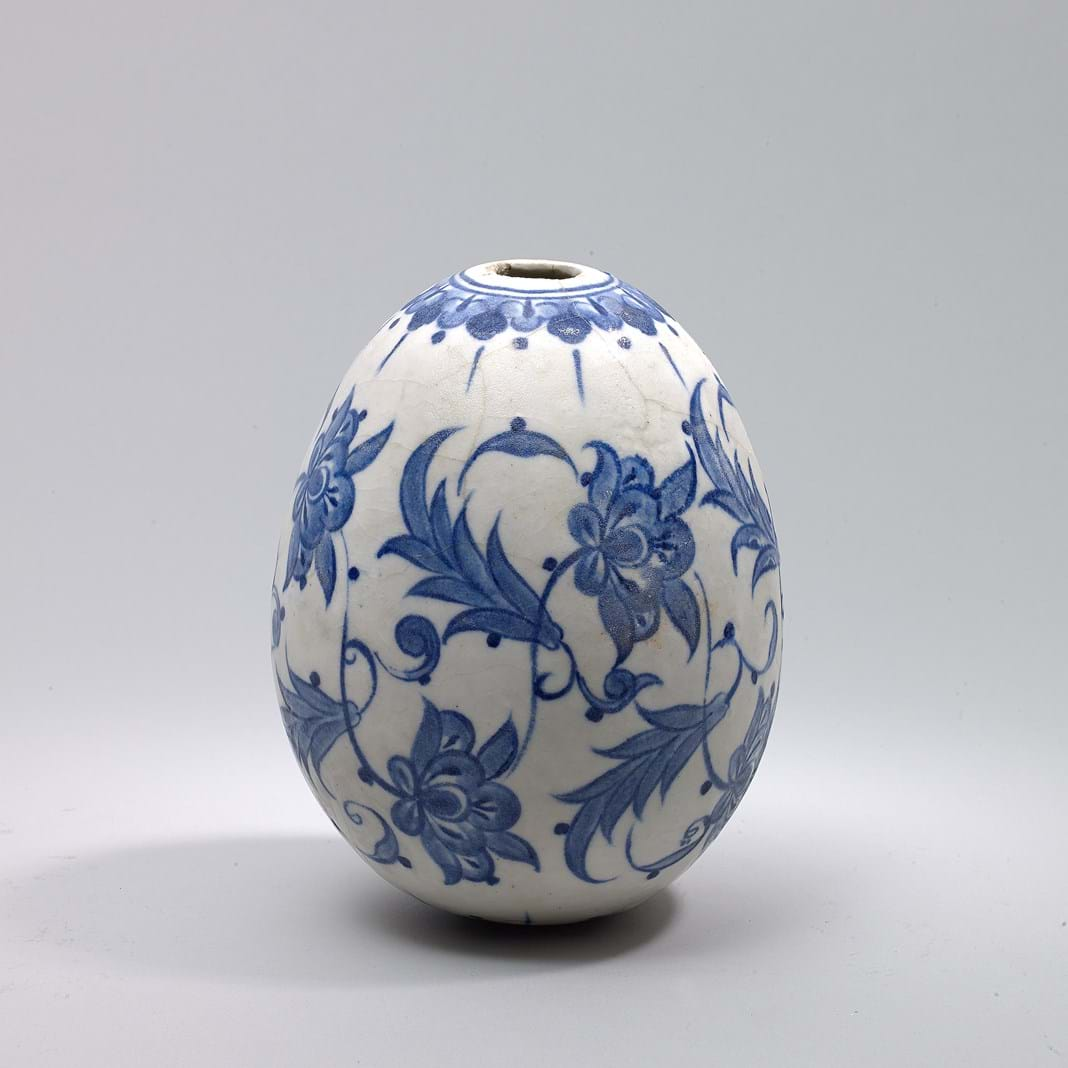Parcel gilt flask or finial
The shape is a miniature version of the large ceramic oil or wine containers with a pointed bottom for setting them in sand at the cargo hold of a ship. That would suggest a similar use for this object as a small flask. However, an almost identical object in a private collection is described as a furniture terminal (see: Spier, J., Treasures of the Ferrell Collection, Wiesbaden, 2010, p.292, cat.213)
Origin
Constantinople or Eastern Mediterranean
Date
Late Roman-Early Christian period, 6th-7th century
Height: 11 cm
Weight: 39 g
Provenance
Haddad Brothers
Opus sectile panel with a Musenna inscription reading ‘Muhammad’
Like the technically identical Ispenian panel (C001513), the origin and date of this piece is mysterious too. With bold blue letters in Thuluth script arranged in mirror image against a bright yellow ground, it is composed of ceramic tile elements with a red earthenware body covered with an opaque monochrome glaze.
On epigraphic grounds, and if it were not for its undeniable similarity to the Ispenian panel, one would be inclined to place this within the Ottoman world, where we find examples of calligraphy in mirror image (Musenna) as far back as 1500 in book illumination and from at least 1600 painted on tiles. But they all have one thing in common; they are associated with Sufi brotherhoods. Indeed, the rendering of the word Muhammad on this piece appears in a very similar fashion on a 19th-century Sufi drawing.
Origin
Central Islamic Lands
Date
18th century or possibly much earlier
Height: 28.5 cm
Width: 35.6 cm
Provenance
Sotheby's, London, 02/04/2009, lot 124
Acquired there by AXIA
Opus sectile panel with a Kufic inscription reading ‘God is my Master’
To this day, the origin and date of this dramatic ceramic panel in two strongly-contrasting colours remain a mystery. With bold yellow letters against a green ground, It is composed of ceramic tile elements with a red earthenware body covered with an opaque monochrome glaze. These have been cut and juxtaposed to form the pattern. Known as opus sectile, the technique harks back to Roman times. In the Islamic world it is usually associated with tile revetments of the Timurid period. There, however the body material is white, the colour palette is broader, the glazes more translucent and the aesthetic notably different.
In the absence of any recorded monuments with related mosaics, opinions as to the origin of this sui generis panel range from Morocco all the way to northern India, and from the 10th to the 18th century. In the hand-written 19th-century inventory of the Ispenian collection in Cairo, it was recorded as having been acquired from Mosul. Although a priori unlikely, this claim gains some credence by the arrangement of the kufic letters to form a circular medallion, a formula we find on Abbasid coinage and on an early Islamic fresco fragment in the Damascus Museum.
Origin
Central Islamic Lands
Date
18th century or possibly much earlier
Height: 57 cm
Width: 55 cm
Provenance
Ispenian Collection, Cairo, before 1900
Georges Antaki Collection, 1960s
Acquired by AXIA in 1990
Exhibited / Published
UNESCO greeting card in 1990-91
'Reflections of China in an Islamic Mirror' at AXIA for Asian Art in London, 19/11 to 4/12/98, no. 10
A marble water basin carved in high relief
Of bulbous form with a flat rim, the basin sits on a narrow circular foot. At the top, protruding in a cruciform arrangement, four substantial, everted and bulging flanges. The exterior surface is covered in its entirety in a complex arabesque consisting of a variety of split-leaf forms carved in high relief. The pattern divides the surface into four lobed arches, one of which is outlined by a band of calligraphy in kufic script. Further kufic inscriptions below the rim; intact.
Inscriptions:
On the body, the basmala; around the rim, “May it be wholesome” and “May recovery be tender”
The association of these inscription with health, suggests that this basin could have been made for a maristan, (a place of healing for physical and mental ailments run by a pious foundation), where, filled with water, it would have occupied a prominent position, probably on a pedestal at the centre of a courtyard.
Comments
We cannot be certain of the function of the basin. The absence of a hole at the bottom precludes its being a fountain. It is more likely to have been a container for drinking water. Coming to its bulbous form, it echoes the general shape and volume of Byzantine ‘basket’-type column capitals of the 6th century. At first sight, this would suggest it could have been a spolium, a piece from a disused earlier Christian building re-carved in the Islamic period. Closer examination of such capitals, however, shows that their overall form would not allow for the creation of the four prominent protrusions at the corners of our basin. Should it have been a spolium, therefore, the original is much more likely to have been a Late Roman or Early Christian Corinthian style capital, whose prominent acanthus-leaves at the corners could be re-carved into the present shape.
As for the decorative arrangement on the body and the treatment of the foot, we find echoes of these on a 13th-century Ayyubid marble basin from Hama in the Victoria and Albert Museum, London (museum number 335-1903). Closer to the date of our basin, however, are two marble corner posts with domed terminals in the David Collection, Copenhagen (Kjeld von Folsach, Art from the World of Islam in the David Collection, Copenhagen, 2001, p. 245, no. 392). They have similar kufic inscriptions and scrolling foliate decoration based on the split-leaf form. A direct comparison is also provided by the horizontal inscription and the interlacing arabesques on a marble mihrab panel attributed to the early-13th-century, Zangid dynasty that sold a few years ago at Sotheby’s (Arts of the Islamic World, 06/10/2010, lot 136).
For further comparisons, see: Ernst Herzfeld, “Damascus: Studies in Architecture, II. The Cruciform Plan. Syrian Architecture, Period of Nur-ad-Din”, Ars Islamica, X, Freer Gallery of Art, The Smithsonian Institution and Department of the History of Art, University of Michigan, 1943
Origin
Syria or Mesopotamia (Jazira)
Date
11th/12th century
Height: 40 cm
Width: 61.5 cm (max)
Diameter: 45.5 cm (rim)
Provenance
George Moro, Montreal Canada, 1982
Private collection, Montreal (acquired from GM's widow in 1992)
Bonhams, London, 23/04/2013, lot 22
A remarkable matching set of 12 early Byzantine silver serving spoons
The shape and construction of this exceptional set of spoons each consisting of a long slim handle, a pear-shaped bowl and a round disc which connects the handle to the bowl in a stepped joint, is of the standard Late Roman / Early Byzantine type known as a ligula. Their larger than normal size and the absence of a pointed tip to the handle for spearing food morsels, indicates that they were intended for serving rather than for eating.
The interior of the bowls is plain and lightly engraved with a parcel gilt cross (much of the gilding now lost). The exterior is chased and was inlaid with niello (much of it now also lost). It is decorated with two facing peacocks perched on scrolling vines flanking a cross and edged with a narrow border of stylised waves.
The thin long shafts of the handles are made of a single piece of solid silver, but are fashioned in two parts; a short length of hexagonal section at the bowl end, followed by a much longer part of round section which flares gently outwards towards the tip. The facets of the hexagonal part are chased with alternating bands of scrolls and stylised waves, while the surface of the round part is covered in its entirety by a finely-engraved honeycomb pattern, each hexagon of which contains a small cross.
The circular disc of tapering section which provides the stepped joint between handle and bowl is engraved on one side on all 12 spoons with the same monogram which reads IΩANNOV, ‘of John’ or ‘belonging to John’.
In Late Antiquity the control of production and distribution of all silver, including tableware, was under the authority of the emperor. Its use and possession, however, was not restricted to the highest imperial ranks, but could be purchased for personal use by wealthy private citizens. Thus fine tableware formed part of the contents of every aristocratic household. Indeed, the price of silver was not so exorbitant as to prohibit members of the upper-middle-class from affording single pieces. Although archaeological finds document the presence of late Roman luxury tableware across Europe and all the way to Scotland, it is generally accepted that the custom of using precious utensils for eating originated in the eastern parts of the Roman Empire.
As for this unique matching set, the presence of 12 identical serving spoons indicates it would without doubt have graced the banquets of a very grand household. Its survival provides poignant testimony to the cultural sophistication of the Eastern Mediterranean in the early Byzantine period. The delicate craftsmanship of the beautifully engraved bowls and the elegance of the handles, attests to their having been fashioned in a metropolitan workshop catering to an aristocratic clientele. The most likely place for the manufacture of this set therefore is likely to have been the Empire’s capital, Constantinople, although one cannot exclude some of the other great cities of the Roman East such as Alexandria, Antioch, or Nicomedia.
Coming to a dating of this set, the formula of the monogram with the letters in a cruciform arrangement first appears during the reign of Justinian in the mid-530s and become commonplace soon after. Another pointer is the similarity of the decoration on the bowls’ exterior with marble reliefs from Ravenna dating from the middle and the 2nd half of the 6th century. Taken together, a similar date seems appropriate for this set.
Origin
Constantinople (?)
Date
Early Byzantine period; 6th –7th century
Length: 23 cm
Size / Dimensions
Weight (each): ranges from 66.97 g to 76.58 g
Weight (all 12): 863.31 g
Provenance
Private collection
Rock crystal cosmetics bottle or container in the shape of a fish
Origin
Constantinople or Eastern Mediterranean
Date
Late Roman-Early Christian period, 3rd-5th century
Length: 8.5 cm
Provenance
Micheal O'Hara 1968
Private collection UK until 2002
NM, London (acquired 2002)
Gilt silver belt buckle in the form of a scallop shell
For a a similar set of buckles, see: Spier, J., Treasures of the Ferrell Collection, Wiesbaden, 2010, p.294, cat.214
Origin
Eastern Mediterranean
Date
Late Roman-Early Christian period, 6th-7th century
Height: 6.5 cm
Width: 8 cm
Weight: 673 g
Provenance
Haddad Brothers
Egg-shaped ceramic hanging ornament from a Mosque lamp
Origin
Ottoman Turkey, Iznik
Date
Ca. 1565-1575
Height: 17 cm
Provenance
Artcurial, Paris, 11/04/2013, lot 162
Acquired there by AXIA (and exported with French passport)
